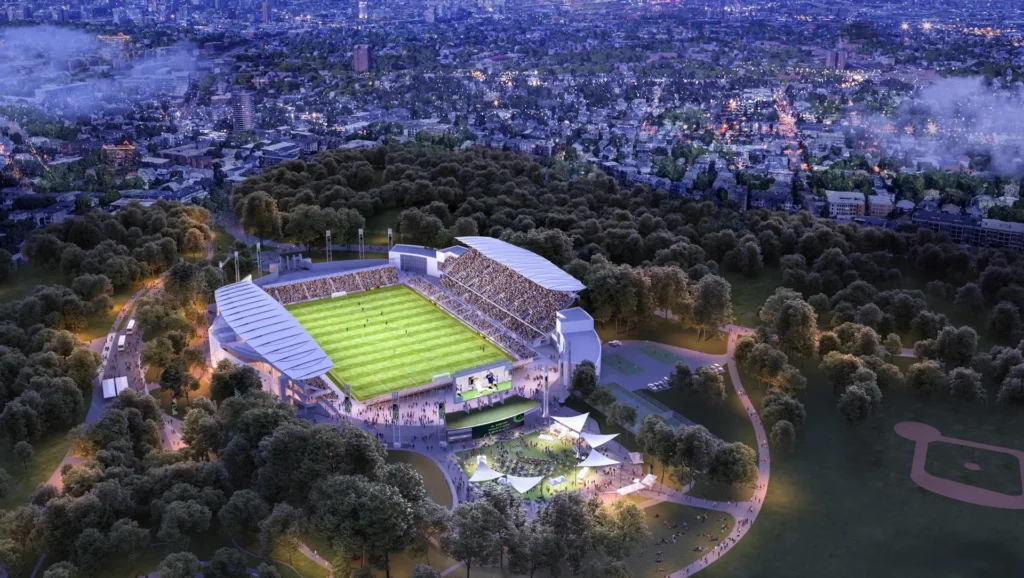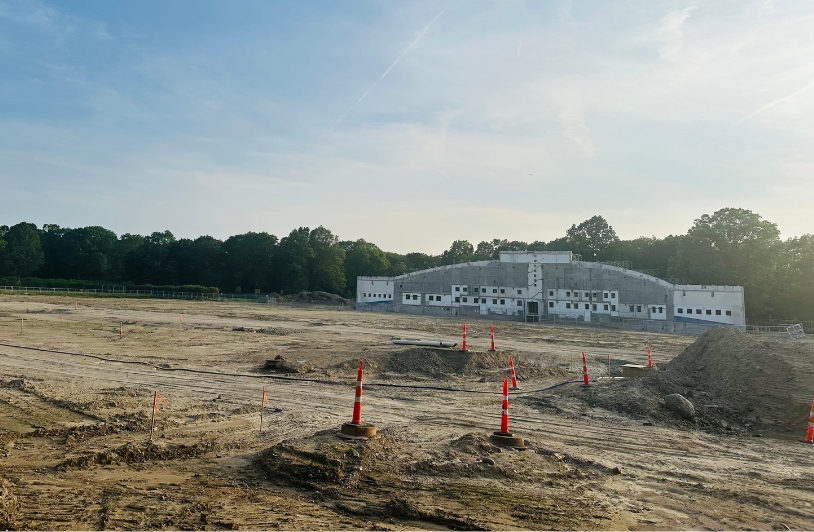BOSTON — There were two competing sounds on the northeast edge of Franklin Park on a chilly February morning, where a fight over the 76-year-old, decrepit White Stadium was reaching a boiling point.
One was the rallying cries of two dozen members of the Franklin Park Defenders, a local citizen advocacy group fighting a city-backed, $200 million plan to transform White Stadium into a state-of-the-art venue for a new professional women’s soccer expansion team, which would double as a home for Boston Public School athletics.
The other was banging noises of cranes and pile drivers, which the city brought in the week prior to demolish the old White Stadium structure — in spite of advocates’ objections.
In February 2024, the Defenders sued the city and soccer owners in an attempt to halt the project, which they believed illegally privatized public land and was moving forward without credible input from local residents. The trial date was scheduled for March 17, and was just one month away when on Feb. 14, the city began demolition.
Boston Mayor Michaelle Wu and the project’s supporters were not in attendance to counter the Franklin Park Defenders, but the cranes in the backdrop did all the talking.
“We are here because of what is behind us,” said Karen Mauney-Brodek, the leader of the Franklin Park Defenders and the director of the Emerald Necklace Conservancy. “Everyone wants to bring investment to Franklin Park. Everyone’s excited that there’s attention on the needs of White Stadium. But I believe the community deserves alternatives. The community deserves to have a voice in that process

The redevelopment of White Stadium has been a contentious topic for decades. The venue lies on the northeast edge of Franklin Park, the century-old, 528-arce park which is the city’s largest outdoor space and the crown jewel of the local community. White Stadium is owned by the Boston Public Schools and served as the city’s youth athletics hub for over a half century, but has been mostly deserted in recent years due to its deteriorated condition.
The White Stadium controversy has created two years worth of news headlines, legal battles, and has even become a key topic in the upcoming Boston mayoral election. But longtime Franklin Park advocates say it’s just the latest piece in a decades-long battle over whose vision of the park’s future will prevail.
“For decades, the preservation of this park has primarily been led by Black residents, and now those residents are being told to step aside and listen to what’s best for us. That is paternalistic and not a true community process,” said Priscilla Andrade, a community advocate and BPS parent who lives just a three-minute walk from White Stadium. “I want to encourage the city to please listen. Just listen. We all know and agree that White Stadium needs a renovation. Our concern is about how, for whom, and by whom?”
Local residents and the city have endured a turbulent relationship over much of Franklin Park’s recent history, though tensions had been gradually easing. In 2018, the city, under previous mayor Marty Walsh, announced plans for an unrelated $28 million investment in the park, and then spent the following three years listening to local residents on how to best make use of the funds.
But for many advocates, those positive sentiments changed once the White Stadium deal was formally announced in September 2023, with plans for a 50/50 cost split between the city and the Boston Unity Soccer Partners, the investor group that paid $55 million for the NWSL franchise.
From the moment the plan was announced, the advocates raised alarms about everything from the use of taxpayer dollars to benefit a private sports franchise, to environmental impacts to the park, to unwanted traffic and visitors from the suburbs. Others countered that without such a plan, White Stadium would likely remain in a desolated condition for years to come – and an imperfect compromise was far better than the alternative of nothing.
But those residents never felt their opposition to the project was taken seriously, in large part due to the timing of the decisions. In February, the Boston Herald reported that discussions between the team and Wu’s administration began in September 2022, seven months before the city began publicly soliciting proposals for a White Stadium design plan.
“You hear [the city] say there were two years of process. All of the fundamental decisions were already made before the community saw a design,” said Mauney-Brodek. “There was always going to be a partnership between a private entity and a public entity that all was presented to the community, and the community was asked to decide, ‘do you like the benches here? Should it be shaped like this?’…. It was not real input [over whether the project should have happened to begin with].”
In numerous public comments, Wu has rejected that sentiment, saying in a February interview with NPR that “the project very much changed and updated and amended to reflect the public feedback that we heard on all the different needs of community members.”
But on April 3, a Suffolk County superior court judge shot down the Defenders’ lawsuit, ruling that the project does not violate Article 97 of White Stadium’s legal pact, which “establishes a right to a clean environment including its natural, scenic, historical, and aesthetic qualities.”
The ruling was the latest courtroom blow for the Defenders, who are now appealing the decision.

“I will not apologize for investing nearly $100 million in this community, into Black and brown communities, into our students and into Boston Public Schools,” Wu said after the decision was finalized. “We deserve this and we deserve to have the opportunity that generation after generation has passed us by.”
The process has eroded those local community members’ confidence about whether their voice and input is valued, even as they are assured by their elected representatives that the plan is for their benefit. And the process has stoked fears about whether future park investments will be designed to serve the local community’s needs, or whether the park is merely a large plot of land ripe for new commercial ventures.
“As a Black person in this community, I am afraid that this is just the next step to pushing me out of a community that I have been in since 1975,” said Renee Wells, who was in tears at the Defenders’ February protest. “This is gentrification at its worst, and as we continue to fight, we have people that we elected that put us down, that continue to beat us into the ground.”
A park given life by community activism
Franklin Park spans the neighborhoods of Roxbury, Dorchester, Jamaica Plain, and Mattapan, and was designed by world-renowned landscape architect Frederick Law Olmsted in 1885. The park is two-thirds the size of New York’s Central Park, Olmsted’s most famous design. Among Franklin Park’s most prominent features are an 18-hole golf course, a zoo, ballfields, miles of bike and walking paths, and White Stadium.
According to Ethan Carr, a professor of landscape architecture at UMass Amherst and the author of “Boston’s Franklin Park: Olmsted, Recreation, and the Modern City,” the park had a prolonged period of prosperity in the first half of the 20th century, while serving the newly formed “streetcar suburbs.” At that time, the surrounding neighborhoods primarily consisted of second- and third-generation Irish, Italian, Jewish, and Canadian immigrants.
It was during this age of prosperity for Franklin Park that White Stadium was built for $8 million, designed as the state-of-the-art hub of BPS athletics.
But by the mid-1950s, the demographics of the Roxbury and Dorchester neighborhoods began changing. As the white population moved to the further-out suburbs of Brookline, Newton, and Wellesley, Black Americans and immigrants from the Caribbean and Asia moved into the area, which quickly transformed into majority-Black neighborhoods.
It was this White Flight, Carr argues in his book, that helps explain why the city’s maintenance of Franklin Park in the 1950s and 1960s paled in comparison to the first half of the century.
“One of the reasons for that demise — in addition to the budget crisis and other reasons — is institutional racism,” Carr said. “Once those neighborhoods became identified as Black neighborhoods, and the park was identified as a Black park, the city simply did not maintain it. They vastly reduced maintenance and any kind of investment in the park.”
Franklin Park became unsafe and unpleasant, as poor upkeep deteriorated the facilities and charm. Like much of Boston during that time, the park was also overrun with drugs and crime. It was at this lowpoint in the mid-1960s that Elma Lewis, a lifelong resident of Roxbury and trailblazer and educator in the Black arts, began grassroots efforts to reclaim the area.
“When [Lewis] started all this, the park was a dump. Point blank. It was not what you’re used to seeing there now,” said Sonya White Hope, a musical educator in Roxbury and Lewis historian. “People would drive up with their trucks, and they’d just take refrigerators and mattresses and just dump it in the park. There were rats everywhere. It was a mess.”
Beginning in the early 1960s, Lewis and dozens of her students from the Elma Lewis School of Fine Arts took it upon themselves to clean up the park, often by literally picking up trash, piece by piece. Lewis’ efforts in spearheading the park’s cleanup and cultural revival paved the way for the 1978 formation of the Franklin Park Coalition.
One of those other members who began the Coalition alongside Lewis was Louis Elisa, who was also the former head of Boston’s NAACP chapter. And those decades of advocacy work are why Elisa, now 76, feels so strongly about fighting the city’s present White Stadium proposal.
“We saved this park from ruin and desolation 47 years ago, and it wasn’t so it could be turned over to a private enterprise to make a tremendous fortune off of and exclude the people who live here in Jamaica Plain, Roxbury, and Dorchester,” Elisa said. “It takes a certain amount of anger and ignorance and dislike for the people who live around this community to take a park that’s a national monument and turn it into an entertainment spot for the rich and wealthy.”
The city moves towards improving the park — but for who?
Today, Franklin Park is a far cry from the disrepair Lewis found it in. It has miles of clean walking trails, well-groomed athletic fields, an improved zoo, a well-acclaimed golf course, and hosts successful community events each year.
But there is a feeling among some local residents that the park could be so much more — and that it needs protection by those with interests outside of exclusively the local community.
The stage for a larger civic investment was set in 2018, when the city of Boston sold the downtown Winthrop Square Garage to developers for $163 million. The developers’ plan to build a skyscraper on the garage site — which opened earlier in 2023 as the 62-story Winthrop Center — was opposed by advocates at the time, since the proposed building would cast a shadow over the park in the mornings.

The advocacy group, Friends of the Public Garden, fought to stop the project, though they stopped short of suing the city. As a compromise to get the deal approved, the city agreed to set aside some of the sale’s proceeds to fund major investments into both Boston Common and Franklin Park.
The $28 million of funding for Franklin Park enabled the city to widen its scope for refurbishing the park, and the city embraced the advocacy groups as key partners in bringing that plan to fruition.
Liza Meyer, Boston’s chief landscape architect, said the city initially expected the outreach, surveying, and design process to take roughly two years. But the timeline for producing a plan slowed due to the combination of COVID and extended deliberation involving local residents, other interest groups, and other complicating factors — as it could still be years until shovels are in the ground.
“It’s been very clearly represented to me that there was a lot of mistrust and that the city hadn’t done well by the park in the past,” Meyer said. “I think that if you make the park work for the people who are already using it, then you already sort of naturally back into making it feel welcoming and inviting to others as well.”
That context made the White Stadium proposal particularly disheartening for many local residents who spent years in productive conversations with Meyer and the other city stakeholders regarding the action plan — only for an entirely new project to be sprung on them in 2023, without first learning if the community wanted it.
“This is really a question about self determination and agency the city went through,” said Andrade, a community advocate. “We went through a lengthy process [more than] two years with the Franklin Park Action Plan, and even that was a little bit difficult. But we gave room for disagreement, dissent, correction, adjustment, etc. Nowhere in that plan was there a promise for a world-class sports stadium.”
To provide a concrete alternative vision, the Defenders hired an outside architectural firm and developed a separate $28.9 million proposal to renovate White Stadium solely for the needs of Boston Public Schools students, with no professional soccer franchise tenant. The capacity would be 5,000, and cost one-eighth of the current project (and one-fourth of the city’s investment).
However, the city called that plan “unrealistic” and claimed that after an official review process, which would factor in ADA compliance and other materials costs, the plan would more than double in estimated cost.
But all of the controversy effectively ended when the Suffolk County judge ruled on April 2 that the renovations at White Stadium at Franklin Park can continue, and that the stadium is not protected as park or conservation land.
“In a city of sports champions, this is a historic victory,” Wu said at a press conference outside White Stadium on April 3, the day following the victorious ruling. “Together, after so many years of broken promises, we will give our young people and all our residents the scale of investment and opportunity that Franklin Park and our city deserve.”
Jean McGuire, a Roxbury resident and one of the plaintiffs in the legal case, said the Franklin Park Defenders were disappointed by the trial’s outcome — though not surprised.
“Our community is used to seeing laws meant to protect the public get trampled when the rich and powerful see an opportunity to make money,” said McGuire. “Despite this outcome, we still believe that our community deserves an alternative to an oversized, for-profit sports and entertainment complex in Franklin Park.”
Other local residents and BPS students argue that while imperfect, it is a far better solution than what currently exists. While one of the stadium’s two grandstands will be dedicated to the soccer team, the plan will designate the other grandstand for BPS athletes. The facility will include locker rooms, strength and conditioning rooms, sports medicine space, student lounges, coach offices and a community kitchen.
Tony DaRocha, a retired BPS track coach, said in a public forum in February that Boston student-athletes shouldn’t have to settle for the poor conditions they’ve endured for years at the city-owned stadium, and settling for a compromise would benefit the students in the long run.
“Having access to facilities is something really important to have and to understand the strength of public-private partnerships,” DaRocha said. “I know they work. In Boston, the problem we have is we can’t maintain our facilities.”
But to the advocates on the Franklin Park Defenders’ side, compromise in the face of being held voiceless is not really a compromise — but rather, someone else’s vision imposed onto them.
“At the very beginning of this process, we asked, are there any alternative plans? And the city’s response was no. It’s this or nothing,” said Andrade. “And that, I think, is really indicative of the order of priority. If it’s only this public-private partnership or nothing, then it’s really not about Boston Public Schools. It’s not really about public park use, and it’s really not about the general public, because we’re not being engaged in that process in a way that actually serves us.”
The stadium is slated to open in 2027, and will bring about visitors for the team and breathe life into BPS athletics programs in dire need of athlete facility upgrades. Some will argue the compromise was worth it, while others will believe the project’s motives were disingenuous or misguided. But Mauney-Brodek and the Defenders will not stop advocating or fighting.
“This is disappointing, but we will not stop,” Mauney-Brodek said after the decision. “This is about fighting for our community, and that doesn’t end.”
“FREEDOM OF THE PRESS IS NOT JUST IMPORTANT TO DEMOCRACY, IT IS DEMOCRACY.” – Walter Cronkite. CLICK HERE to donate in support of our free and independent voice.




